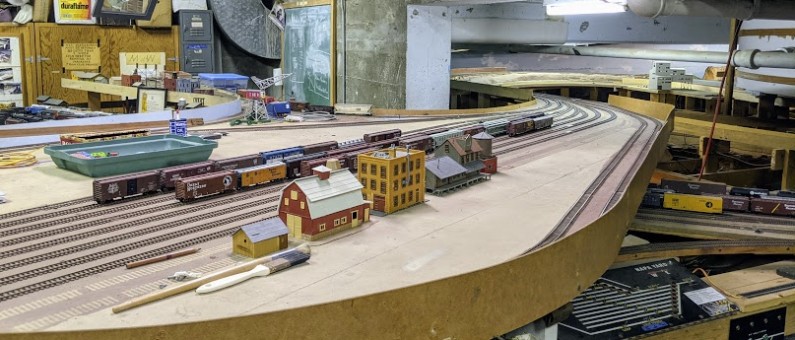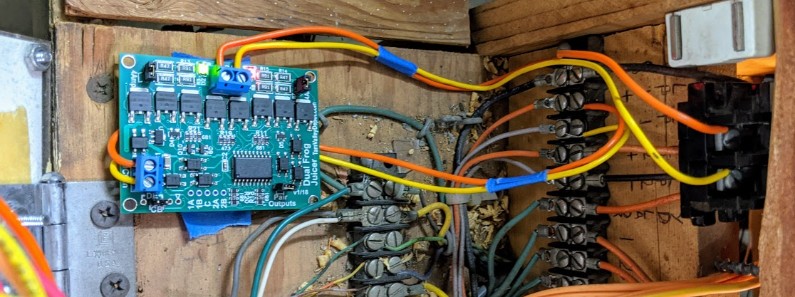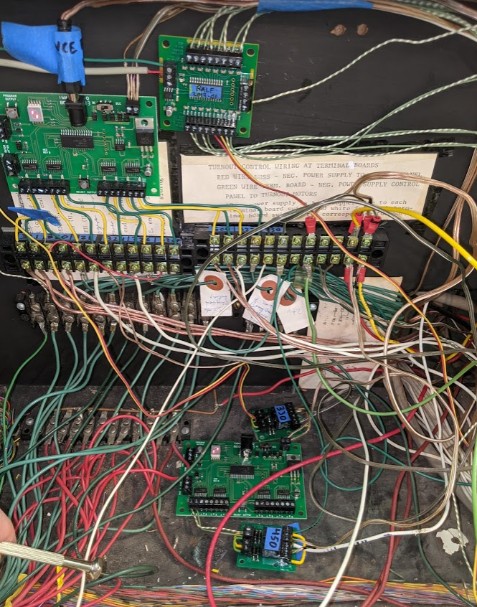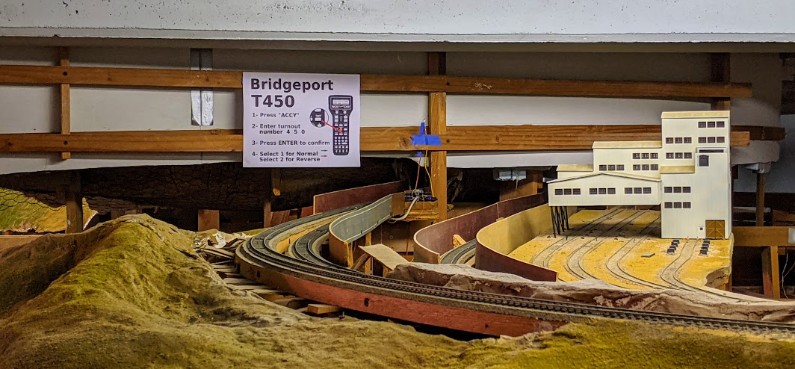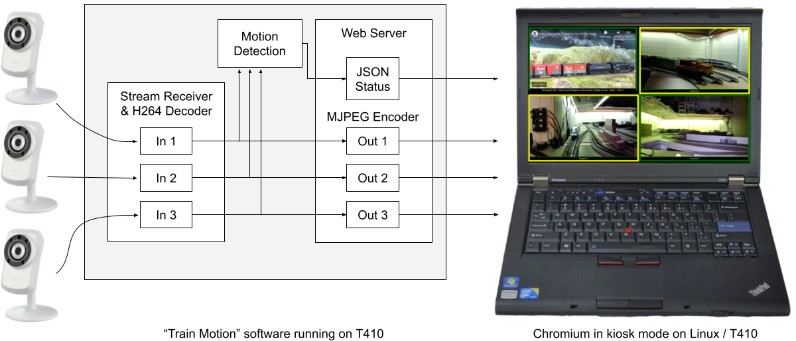The Randall Museum in San Francisco hosts a large HO-scale model railroad. Created by the Golden Gate Model Railroad Club starting in 1961, the layout was donated to the Museum in 2015. Since then I have started automatizing trains running on the layout. I am also the model railroad maintainer. This blog describes various updates on the Randall Museum Model Railroad and I maintain a separate tech blog for all my electronics & software not directly related to Randall.
Bridgeport after some more cleaning and adding a few structures we had laying around:
Today I cleaned the inner balloon track of Bridgeport using our cleaning engine 1201:
As indicated yesterday, the strategy is:
- Manual scrub the track with the Woodland Scenics Track Cleaning tool.
- Run 1201 pushing a roller and pulling a pad car.
- One drop of ATF on the roller pad does help a lot.
- The ATF is combined with manual scrubbing and then running 1201 back and forth several times -- rinse and repeat till the engine goes on smoothly.
What I found in the past is that using too much ATF or Wahl oil just makes the track slippery and attracts more dust in the long run. However one drop of ATF spread out by the roller car creates a smooth film which is visible at first. Then with the scrubber, it does help clean the track till it’s shiny enough and we don’t notice any ATF on it.
I also installed the auto-reverser on the outer “Loop 1” balloon track:
I’m using a Tam Valley Frog Juicer Auto-reverser; I really like them, they work very nicely.
Click here to continue reading...
I guess a better title would be “Digitrax DS64 and Fulgurex do not match”. Well, sort of.
From http://www.clag.org.uk/fulgurex.html:
“Fulgurex motors, as best as I can find, draw around 200 mA when in motion.”
And Digitrax has a technote for the DS64 essentially saying to not even try:
“the Fulgurex motor draws too much current for the DS64”
Although the Digitrax technote indicates the Fulgurex could use “up to 400 mA”, which seems a bit excessive… or is it? I did notice on the Napa ones that I do have a severe voltage drop when driving two (!) Fulgurex at the same time (it’s a crossover). IIRC it was in the 5-6 V range instead of the expected 10-12 V. That means we’re taxing that little DS64 yet the Napa Fulgurex(es) still manage to work, albeit a bit weakly.
That did not work with the Bridgeport Fulgurex though. Voltage was dropping at 3-4 V, which was not enough. Likely that one is using a bit more current.
Anyhow, the Digitrax DS64 I installed last week is out, and in goes a new NCE Switch-8 with an NCE Relay Board to control that Fulgurex, and now everything works as a charm:
The panel is still a mess though, and this is wired as such:
Click here to continue reading...
We now have DCC control for the Bridgeport turnout, with some caveat:
For this I used a Digitrax DS64 to control the Fulgurex slow-motion motor.
As I said… “with some caveats”:
Click here to continue reading...
2020-10-13 - Lodi & Fairfield
Category RandallHere’s something nice: Jim is having a good time operating on the layout at Randall. You can read the details in his Train Orders post: SP Operations Today On Randall Museum Model Railroad.
I did spend some time cleanup the Napa yard, and making the Napa-mainline interchange more functional, and this is paying off.
Jim has also started using Lodi for switching. I’m really glad to learn that. First it’s a really neat part of the layout that is quite underused. Second I appreciate the use of it for switching operations, and not just running in a loop. Having operational variety is the whole point of a layout like the one designed at Randall.
That came with a request, which I fully support:
Click here to continue reading...
2020-09-27 - State of Projects
Category RandallTime for a little recap on pending projects, and a vague attempt at prioritizing them. This is an update for my post [2020-02-29 - Pending Work on the Layout]. Not going to make a fancy table this time, yet the same categorization as before is relevant, namely impact on layout running, impact on public viewing, and time/complexity.
The slight difference is that right now I am not prioritizing immediate public viewing since the museum is still closed till further notice. However we have weekly running to keep the track clean, so even if automation is off for a little bit, the layout must be running.
Currently, these are the projects I expect to be working on, in this order:
- ESP32-CAM for Grade Crossing.
- Impact: Immediate for running / public.
- Complexity: High. Lots of uncertainties. Time consuming R&D.
- Really needs an initial prototype. It’s a two-phase project: validate the concept, then implement the real one. Don’t expect something right away -- thus avoid advertising it before it is known to be functional.
- Power block for Stockton station.
- Impact: None for running, none visible for public automation.
- Complexity: Low. Just time consuming pulling wires.
- Will open the door for adding block sensors in the Stockton yard and providing more automation.
- This may help with the stopped automation train being affected by DCC commands in Stockton Yard.
- Finish 3rd turnout indicator in the Napa approach.
- Impact: Medium-useful for running
- Complexity: Low.
- Complete Conductor 2 software.
- Impact: None for running, none visible for public automation.
- Complexity: High. Long term.
- Will open the door for more automation down the road. I have a partial early prototype, which I never fully finished fletching out. There are still some open questions as to whether the new design can do what I need, then it needs to be fully implemented.
As usual, it needs to be said this list is dynamic. I will adjust my priorities as I see fit. Any maintenance repairs on the layout take priority.
There are other pending projects, which I honestly do not see working myself on in a reasonable time frame:
Click here to continue reading...
Jim is getting a new crossing signal for the Fairfield station:
This is to replace the previous version I did:
A bit of history on what happened to the signal that can be seen in the video, and a personal rant:
The old signal and its controller were removed by Marvin Chow when the GGRMC closed in 2015 -- from what I understand, he had donated such a signal a decade or so ago before leaving the club; the signal had failed and I had replaced it, and then he removed the one I had installed without asking anyone, claiming it was his and proceeded to donate it again to the Carquinez MRR. Rather pathetic to even claim to donate something and then take it back with the typical sleazy excuse of “well I didn’t really donate it, it was a loan”... sure. Whatever.
Anyhow, Jim got a new crossing signal, and we need to power it. Last time I connected it to a LogicRail Tech Grade Crossing Pro and its associated Bell sound module. These are the elements that were taken out unceremoniously. I could reuse the same -- they work well, within their limitations, or I could try to make an Arduino version and experiment in the process.
Click here to continue reading...
Here’s what’s been keeping me busy for the past two weeks at home:
“Vision” a.k.a. Train Motion (source, MIT license) runs full screen on a laptop and plays a series of Youtube videos of the model railroad in a loop. Three cameras point to the layout and, when activity is detected on these cameras, the view changes to a matrix displaying both the Youtube video as well as the three layout cameras, showing whatever train is going by. Once the train is gone, the Youtube video plays full screen again.
Visitors get to enjoy an interactive display -- either a curated series of pre-recorded videos, or live action of the trains running on the model railroad.
Here is a video demonstration of “Train Motion” in action at Randall:
Presentation video (Subtitles are available, use the [CC] button on the video to see them).
Click here to continue reading...
As indicated in the latest update, I added some LEDs indicating when the turnouts are left thrown on the mainline. After experimenting with some LEDs at home, I’m using a single red LED that is on when the turnouts are thrown:
Eventually I would like to have a little dwarf signal there instead of just a LED protruding from the scenery. I was hoping I could 3D print some at work yet I still don’t have access to the 3D printers due to the lockdown -- there are some dwarf signals available to buy online of course, yet that’s one project where printing my own would be a fun task. I’m not in any hurry and I may be able to access the 3D printers by the time the museum reopens anyway.
Both T151 and T162 have been equipped. Eventually I’ll add one for T150 too. I cannot force the Saturday Operators to pay attention to the signals, yet at least that’s a spot where I can make the layout usage a tiny bit less error prone.
2020-05-02 - Ongoing Maintenance
Category RandallAlthough the museum is still closed, the situation here is somewhat relaxing; consequently Jim and I ventured to the museum to do some much needed track cleaning -- our concern was that many months of non-usage would make the track harder to clean, and we believe some regular maintenance will help avoid downtimes when it is time to re-open. Luckily we completed that task without any difficulties.
I have using this workflow for light track cleaning with good success:
Click here to continue reading...
A Shelter-in-Place Order was issued Monday March 16, 2020 for the City and County of San Francisco and other Bay area counties and will remain in effect until April 7. The Randall Museum is currently closed to the public and is in between used for the Emergency Child Care Center effort organized by the city.
More information here:
- https://www.randallmuseum.org/randall-museum-update-3-18-2020-regarding-shelter-in-place/
- https://sfmayor.org/article/san-francisco-issues-new-public-health-order-requiring-residents-stay-home-except-essential
- https://sf.gov/information/san-francisco-converts-rec-facilities-emergency-child-care-centers
- https://sf.gov/topics/coronavirus-covid-19
As a volunteer, my presence there is non essential. I have a lot of work pending on the layout that will just have to wait.
From a technical point of view, that means the layout will not run for many weeks in a row. That may be a problem as tracks oxidize and gather dust when there are no trains running for a long period of time. Thus I fully expect we (and by “we” I mean essentially just me alone) will have to spend quite some time going in there and manually scrub the track to make sure trains still run smoothly. Some folks naively think it’s as easy as just running a track cleaning car, and my experience is that nothing beats actual elbow grease to scrub the track in the accessible areas.
I could ask the museum staff to run the trains once a week. I’m going to venture that they have reduced staff numbers and more urgent things to focus on. And even that would just induce a different issue, namely that all that dust accumulates over time as gunk on the train wheels. We need to clean them monthly or it can become significant enough to derail them.
